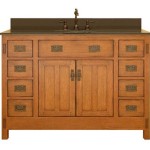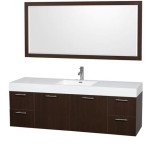What Are The Sizes Of Bathroom Vanities?
Bathroom vanities are essential components of any bathroom design, providing storage, a surface for personal care activities, and contributing significantly to the overall aesthetic. Understanding the standard sizes of bathroom vanities is crucial for planning a renovation or new construction project. Selecting the appropriate size vanity ensures optimal functionality, comfortable use, and efficient space utilization. This article explores the various dimensions of bathroom vanities, covering standard widths, depths, heights, and factors influencing size selection.
Standard Widths of Bathroom Vanities
The width of a bathroom vanity is a primary consideration, largely dictated by the available space in the bathroom and the desired amount of counter space and storage. Vanities are typically measured horizontally, from one outer edge to the other.
Small Vanities (18-30 inches wide): Ideal for small bathrooms, powder rooms, or guest bathrooms, these vanities maximize space efficiency. They often feature a single sink and limited storage, typically consisting of a small cabinet or drawer. These smaller widths are suitable for bathrooms where space is a premium and elaborate storage is not required.
Medium Vanities (30-48 inches wide): These vanities strike a balance between storage capacity and space occupancy, suitable for average-sized bathrooms. They generally include more storage options compared to smaller vanities, such as drawers, shelves, and cabinets. A 36-inch vanity is a common choice as it provides sufficient counter space without overpowering the room. This range allows for comfortable use by a single person and can accommodate a variety of sink styles.
Large Vanities (48-72 inches wide): Best suited for larger bathrooms or master bathrooms, these vanities offer ample counter space and abundant storage. They are often equipped with double sinks, providing convenience for multiple users. This size range allows for more elaborate design features, such as integrated seating or specialized storage compartments. For households with multiple occupants or those who value considerable personal space, these larger vanities are a practical choice.
Extra-Large Vanities (72 inches and wider): Reserved for very spacious bathrooms, these vanities provide the ultimate in luxury and functionality. They can accommodate double sinks with generous counter space around each and offer extensive storage solutions. These vanities can function almost as a dressing table, incorporating features like built-in makeup areas or linen storage. They generally represent a significant investment and are most often seen in high-end bathroom designs.
When selecting the width of a bathroom vanity, it's crucial to measure the available space accurately and consider the placement of other fixtures, such as toilets and showers. Ensuring adequate clearance around the vanity is essential for comfortable movement and accessibility within the bathroom.
Standard Depths of Bathroom Vanities
The depth of a bathroom vanity refers to its measurement from the front edge to the back wall. Standard depths impact not only the functionality of the vanity but also the overall flow of the bathroom.
Standard Depth (20-21 inches): This is the most common depth for bathroom vanities, providing sufficient space for most sink styles and accommodating plumbing connections behind the cabinet. This depth allows for comfortable standing distance from the sink and minimizes the overall footprint in the bathroom. Vanities with a standard depth are versatile and can be integrated into various bathroom layouts.
Shallow Depth (16-19 inches): Designed for small bathrooms or powder rooms where space is limited, shallow depth vanities sacrifice some storage capacity to conserve space. These vanities often feature smaller sinks and streamlined designs. They are suitable for tight spaces where a standard depth vanity would obstruct movement. Despite their reduced depth, these vanities can still provide adequate functionality while maintaining a clean and uncluttered appearance.
Extra Depth (22 inches or more): These vanities offer increased counter space and storage capacity. The extra depth allows for larger sinks or additional space for personal care items. These vanities are generally found in larger bathrooms where space is not a constraint. The increased depth can also accommodate more elaborate cabinet designs and storage solutions.
The depth of the vanity should be selected based on the bathroom's layout and the user's preferences. A deeper vanity offers more counter space but can make a small bathroom feel cramped. A shallower vanity maximizes space but may compromise on storage and usable surface area. Careful consideration of these factors is essential for selecting the appropriate depth.
Standard Heights of Bathroom Vanities
The height of a bathroom vanity is a critical factor for comfort and accessibility. Standard heights have evolved over time, reflecting changing ergonomic considerations and user preferences.
Traditional Height (30-32 inches): This was the standard height for many years and is still common in older homes. However, it can be uncomfortable for taller individuals, requiring them to bend over excessively to use the sink. While still available, traditional height vanities are becoming less popular as taller options gain prevalence.
Comfort Height (34-36 inches): This height is designed to provide a more ergonomic and comfortable experience, particularly for taller users. Comfort height vanities reduce the need to bend over, minimizing strain on the back and neck. This height is becoming increasingly popular in new homes and renovations, reflecting a greater emphasis on user comfort and accessibility.
Custom Height: Custom-height vanities offer the flexibility to tailor the height to specific needs and preferences. This is particularly useful for individuals with disabilities or those who require specific ergonomic considerations. Custom vanities can be built to any desired height, ensuring optimal comfort and accessibility for all users.
When selecting the height of a bathroom vanity, it's important to consider the height of the primary users. A taller person may find a comfort height vanity more suitable, while a shorter person may prefer a traditional height vanity or a custom height that accommodates their reach. Accessibility considerations should also be taken into account, particularly for individuals with mobility limitations.
Beyond the standard measurements, several other factors influence the overall size and suitability of a bathroom vanity. These include the style of the sink, the type of countertop, and the overall design aesthetic of the bathroom.
Sink Style: The type of sink significantly impacts the dimensions required for the vanity. Undermount sinks, where the sink is installed beneath the countertop, typically require a deeper vanity to accommodate the sink basin and plumbing. Vessel sinks, which sit on top of the countertop, add height to the overall vanity, requiring careful consideration of the combined height of the vanity and sink. Integrated sinks, where the sink and countertop are molded into a single unit, offer a seamless and often space-saving design.
Countertop Material: The thickness and material of the countertop can also influence the overall dimensions of the vanity. Thicker countertops, such as granite or marble, can add to the overall height of the vanity. The choice of countertop material should be considered in conjunction with the vanity's dimensions to ensure a cohesive and aesthetically pleasing design.
Bathroom Layout: The layout of the bathroom is a crucial factor in determining the appropriate size of the vanity. Small bathrooms require careful space planning to ensure that the vanity does not obstruct movement or make the room feel cramped. Larger bathrooms offer greater flexibility in vanity size and placement, allowing for more elaborate designs and storage solutions.
Storage Needs: The amount of storage required should also influence the selection of a bathroom vanity. Individuals with extensive personal care items may require a larger vanity with ample storage compartments. Those with minimal storage needs may opt for a smaller, more streamlined vanity. Consideration of storage requirements is essential for ensuring that the vanity meets the functional needs of the bathroom.
Plumbing Considerations: The location of existing plumbing lines can also impact the placement and size of the vanity. It's important to ensure that the vanity can be easily connected to existing plumbing without requiring extensive modifications. Consulting with a plumber during the planning phase can help identify any potential plumbing-related challenges.
Accessibility Requirements: For individuals with disabilities or mobility limitations, accessibility requirements should be a primary consideration in selecting a bathroom vanity. This may involve choosing a vanity with a lower height, ensuring adequate knee clearance, or incorporating grab bars for support. Adhering to accessibility guidelines ensures that the bathroom is safe and usable for all individuals.
Selecting the appropriate size of a bathroom vanity requires careful consideration of various factors, including the available space, storage needs, user preferences, and accessibility requirements. By understanding the standard dimensions and considering the specific needs of the bathroom and its users, it is possible to choose a vanity that is both functional and aesthetically pleasing. Proper planning and attention to detail are essential for ensuring a successful bathroom renovation or new construction project.

What S The Standard Depth Of A Bathroom Vanity

Plan Your Bathroom By The Most Suitable Dimensions Guide Engineering Discoveries Vessel Sink Vanity Floor Plans Washbasin Design

What Is The Standard Bathroom Vanity Height Size Guide

Plan Your Bathroom By The Most Suitable Dimensions Guide Engineering Discoveries Vanity Sizes Vessel Sink
Bathroom Vanity Sizes In Optimizing Space And Style For Every Wellsons

What Is The Standard Height Of A Bathroom Vanity

Pin By Tania Rejalaga On Bathroom Ideas Vanity Sizes Dimensions Modern

What Is The Standard Height Of A Bathroom Vanity

Dhp Sunnybrooke 30 Inch Bathroom Vanity With Sink Black Com

Modern 36 In W X 18 D 32 H Bath Vanity White Ceramic Top With Sink And Brown Storage Cabinet Ba Wh36 The Home Depot
Related Posts







